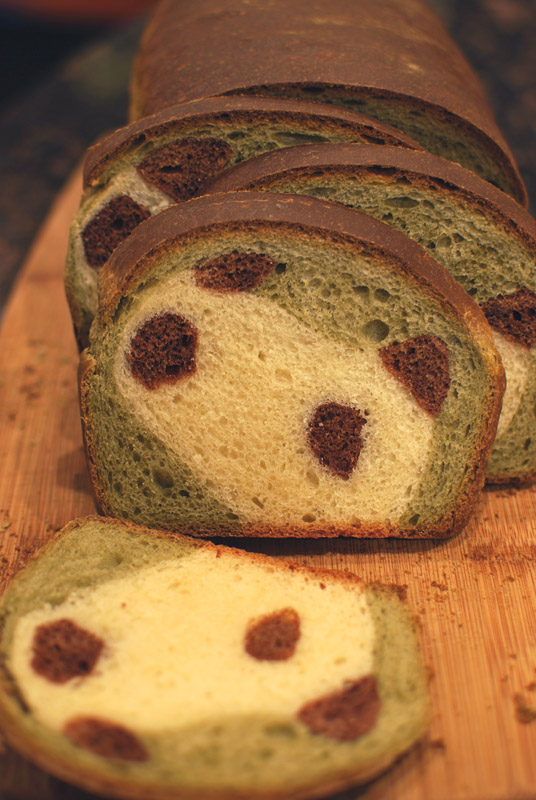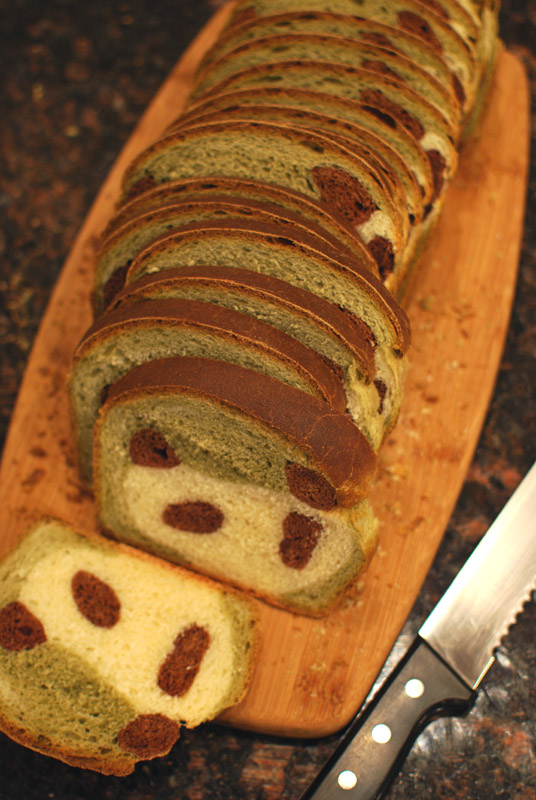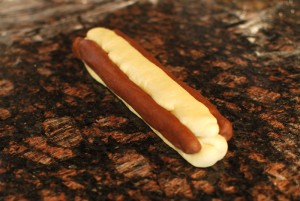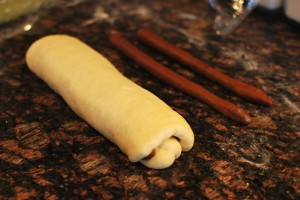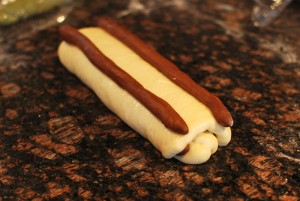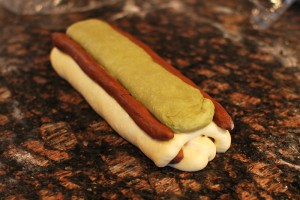Week Thirty-Five: East Asian Breads
To finish out East Asian Bread Week, I’ve chosen a bread that could have come from nowhere but Japan. I know it’s made the bloggy rounds, but the moment I saw it, I knew I had to have my own try at making Panda Bread.
Yeast bread was essentially unheard of in Japan (aside from that made by a small Portuguese population, since the 1500’s) until the mid-1800’s, when the nation, isolated by the Sea of Japan, began to reach out more to the Western world that had infused much of Asia with money. Trade with the West brought businessmen, who of course brought their customary cuisine with them. Government encouragement to embrace all things Western helped seal the deal, and the Japanese found a new love: white bread.
That gleamingly-pale, soft-crusted, fluffy-crumbed stuff, white bread is perhaps even more popular in Japan than it is in America, Home of Wonder Bread. It certainly comprises the largest percentage of type of bread sold in Japan today. I mention this because when you get right down to it, today’s bread is a very average white bread, despite the coloring. It’s not very exciting in flavor or texture; in fact there’s hardly anything remarkable about it at all.
Well, except for the panda face. Did I mention the flippin’ panda face, baked right into the dough? There’s a face! Of a panda! Pandas, of course, are only found naturally in China, so there’s the one non-Japanese thing about it. But I understand that Japan has been known to appreciate the odd bit of cuteness now and then, and panda faces are undeniably cute; so we’ll have to indulge this one tiny lapse.
Considering all this in light of the rich and fascinating tradition of decorative food in Japan – sushi, anyone? – you understand why today’s bread is nothing but Japansese. This extremely delightful and wholly unnecessary artistry is accomplished by some clever and easy dough shaping, which I’ve illustrated below with copious photos. I think it’s all made pretty clear, but I’m happy to answer any questions that may arise.
The base dough is, as previously mentioned, a fairly standard white bread, lightly sweetened and enriched with a touch of butter. Coloring is added to this dough with cocoa powder, producing the dark colored bits, and with green tea powder, producing the green colored bits. That’s right, there’s no dodgy food colorings here; it’s totally natural. In case you think it strange to use tea as food coloring, green tea powder (aka: matcha) is often used to color food in Japan; you may have seen it used in ice cream at a sushi restaurant.
Though this bread won’t win any blind taste tests, there’s no denying its appeal, especially for the young (or the young-minded). The sandwich I made with it may have tasted a little dry, but I’d be lying if I said there wasn’t a smile on my face the whole time I was eating it. You just can’t be sad when you’re nibbling on panda ears for lunch.
Kawaii desu ne!*
Panda Bread
Adapted from Taro Taro
Makes one 9 x 5 inch loaf
15 ounces (about 3 1/3 cups) unbleached all-purpose flour
1 ounce (2 1/2 tablespoons) granulated sugar
1 teaspoon kosher salt
1/2 teaspoon instant yeast
7 ounces milk, at room temperature
1 egg, lightly beaten, at room temperature
1 tablespoon green tea powder (matcha, see note 1 below), dissolved in 1 tablespoon hot water
1 tablespoon cocoa powder, dissolved in 2 teaspoons hot water
1. In the bowl of a stand mixer, whisk together the flour, sugar, salt, and yeast. Add the milk and egg. Using the dough hook, mix on low speed until a rough dough forms, 1 to 2 minutes. Increase the speed to medium-low, and knead for 6 to 7 minutes. The dough should clear the sides of the bowl, and should be smooth and just a little sticky to the touch. Add a little extra flour or water during the kneading process, if necessary to achieve the proper consistency.
2. Turn the dough out onto a work surface, dusting with flour only if necessary to prevent sticking. Divide the dough into three parts: 2 1/2 ounces (75 g) for the cocoa, 7 1/2 ounces (210 g) left plain, and the remainder (about 10 ounces, or 280 g) for the green tea. In each of the following steps, keep the unused pieces of dough covered with plastic wrap while working, and only use just enough flour to prevent sticking.
3. Add the dissolved cocoa paste to the 2 1/2 ounce piece of dough. Knead until the color is even and no streaks remain. Shape into a round ball, set aside, and cover with plastic wrap. Add the dissolved green tea to the 10 ounce piece of dough, and knead until the color is even and no streaks remain. Shape into a round ball, set aside, and cover with plastic wrap. This step may take several minutes. Let all dough rest on the work surface, covered, until doubled in size, about 1 hour. Butter a 9 x 5 inch loaf pan, set aside.
4. Press air out of all pieces of dough until well deflated. Cut off a 3 ounce (90 g) piece of plain dough for the face, and 2 pieces of 1 ounce each (30 g) of the chocolate dough for the eyes. Roll each piece into a rope, making sure all pieces are the same length.
Place the two pieces of chocolate dough lengthwise on top and slightly on the side of the plain dough. If the dough doesn’t stick, spray it lightly with water.
5. Cut off a 1 ounce (30 g) piece of plain dough. Roll it out to the same length as the pre-shaped face and the eyes. Flatten slightly, and place in between the eyes to fill in the gap.
6. Roll out the remaining plain dough into a flat rectangle, as long as the pre-shaped dough.
If the dough resists, cover and let rest for 5 to 10 minutes before trying again. Wrap the plain dough around the face and eyes, pressing to seal around the bottom edges. The loaf should look a bit like a log.
7. Cut off two pieces of the remaining chocolate dough, 1/2 ounce (17 g) each, for the ears. (You may have some chocolate dough left over; either discard or shape into a tiny roll to bake separately.) Roll the dough into two ropes, each as long as the log of pre-shaped dough. Place the ropes lengthwise on top and slightly on the side of the log, spraying with a little water if the dough doesn’t stick.
8. Cut off a 2 1/2 ounce (70 g) piece of the green tea dough, and roll into a rope as long as the pre-shaped dough. Flatten slightly, and place in between the ears to fill in the gap.
9. Roll the remaining green tea dough into a flat rectangle, as long as the pre-shaped dough, and big enough to wrap fully around it. If the dough resists, cover and let rest for 5 to 10 minutes before trying again.
Wrap the green tea dough around the pre-shaped dough, pinching to seal on the bottom.
Carefully transfer the dough, seam side down, to the prepared loaf pan. Take care to ensure that the face is sitting in the center of the pan, not off to one side, and is oriented properly, not rotated or tilted to one direction or another.
Cover loosely with lightly-oiled plastic wrap, and let sit at room temperature until doubled in size, about 1 hour. Thirty minutes before baking, preheat the oven to 375º F.
10. When fully risen, bake the loaf at 375º F for 25 to 30 minutes, or until well-browned. An instant-read thermometer should register about 205º F when inserted into the center (but one of your slices will have a long hole through the face if you do this). Let cool in the pan briefly before transferring to a rack to cool completely before slicing.
Notes:
1. Matcha, or green tea powder, can be found at many Asian markets, particularly ones that specialize in Japanese foods. If you can’t find any, or if you don’t like the slightly bitter and grassy flavor of green tea, you can use a drop of green food coloring, or use any other similar coloring agent. Some people find the green color off-putting, so try other colors if you like. You can make a paste with flour and pomegranate juice for a pink background, or use blueberry juice for an indigo blue background.
2. I found the easiest way to incorporate the coloring (the green tea paste and the cocoa paste) into the dough was to make a very wet paste with the green tea and the cocoa, then add enough flour to make a dough of the same consistency as the bread dough. It was a simple matter of kneading them together by hand after that. Feel free to use whatever method works best for you.
3. Be sure to let this bread cool completely before slicing; otherwise, the structure of the bread will not have set fully, and by cutting too early, the panda face pattern will be spoiled.
* – It’s so cute, isn’t it!

